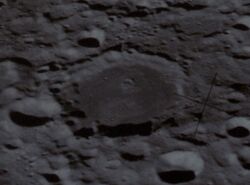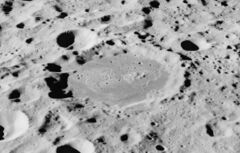Astronomy:Kohlschütter (crater)
 Oblique Apollo 13 image, facing east | |
| Diameter | 56 km |
|---|---|
| Depth | Unknown |
| Colongitude | 206° at sunrise |



Kohlschütter is a lunar impact crater that cannot be viewed directly from the Earth as it lies on the Moon's far side. It is located a couple of hundred kilometers to the southeast of the Mare Moscoviense, and due south of the smaller crater Nagaoka. It is a relatively isolated formation surrounded by a multitude of smaller impacts typical of the battered far side.
The outer rim of Kohlschütter is worn and eroded, with a small crater across the northwest side, and smaller impacts along the west and northeastern edge. The southern rim is more shallow than elsewhere. The interior floor is relatively level, and unlike most far-side craters, it is filled with mare material.[1] Despite its small size, the mare has a short sinuous rille west of the central peak and a wrinkle ridge east of it.
Kohlschütter is a crater of Nectarian age.[2]
Satellite craters
By convention these features are identified on lunar maps by placing the letter on the side of the crater midpoint that is closest to Kohlschütter.
| Kohlschütter | Coordinates | Diameter, km |
|---|---|---|
| N | [ ⚑ ] 11°23′N 153°31′E / 11.39°N 153.51°E | 25.0 |
| Q | [ ⚑ ] 12°55′N 152°45′E / 12.91°N 152.75°E | 18.3 |
| V | [ ⚑ ] 15°25′N 151°37′E / 15.41°N 151.61°E | 19.0 |
| W | [ ⚑ ] 16°09′N 151°01′E / 16.15°N 151.02°E | 31.2 |

References
- ↑ The geologic history of the Moon, 1987, Wilhelms, Don E.; with sections by McCauley, John F.; Trask, Newell J. USGS Professional Paper: 1348. (online), Figure 5-2
- ↑ The geologic history of the Moon. USGS Professional Paper 1348. By Don E. Wilhelms, John F. McCauley, and Newell J. Trask. U.S. Government Printing Office, Washington: 1987. Table 9-4.
- Andersson, L. E.; Whitaker, E. A. (1982). NASA Catalogue of Lunar Nomenclature. NASA RP-1097.
- Blue, Jennifer (July 25, 2007). "Gazetteer of Planetary Nomenclature". USGS. https://planetarynames.wr.usgs.gov/Feature/3071.
- Bussey, B.; Spudis, P. (2004). The Clementine Atlas of the Moon. New York: Cambridge University Press. ISBN 978-0-521-81528-4.
- Cocks, Elijah E.; Cocks, Josiah C. (1995). Who's Who on the Moon: A Biographical Dictionary of Lunar Nomenclature. Tudor Publishers. ISBN 978-0-936389-27-1. https://archive.org/details/isbn_9780936389271.
- McDowell, Jonathan (July 15, 2007). "Lunar Nomenclature". Jonathan's Space Report. http://host.planet4589.org/astro/lunar/.
- Menzel, D. H.; Minnaert, M.; Levin, B.; Dollfus, A.; Bell, B. (1971). "Report on Lunar Nomenclature by the Working Group of Commission 17 of the IAU". Space Science Reviews 12 (2): 136–186. doi:10.1007/BF00171763. Bibcode: 1971SSRv...12..136M.
- Moore, Patrick (2001). On the Moon. Sterling Publishing Co. ISBN 978-0-304-35469-6. https://archive.org/details/patrickmooreonmo00patr.
- Price, Fred W. (1988). The Moon Observer's Handbook. Cambridge University Press. ISBN 978-0-521-33500-3.
- Whitaker, Ewen A. (1999). Mapping and Naming the Moon. Cambridge University Press. ISBN 978-0-521-62248-6.
 |

